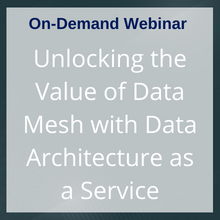Information Architecture and the Human Dimension, Part 2

Automating existing processes or inventing new ones—the old world of application development—leads information architects to define data elements and invent information structures and contexts of use. The internally facing nature of business processes, even when dealing with external entities like customers or suppliers, allows architects to exercise extensive control over the structure and content of process-mediated data that is captured and stored within the business’ applications. In contrast, information received from external sources arrives the way it arrives: its content and structure determined by somebody else for their own needs or purposes. The role of the architect here is to assign meaning and business context to this existing information, so that it can be validly used to support the decision making needs and other purposes of the receiving organization.
Much of the focus on external information so far has been around human-sourced information from social media, but the emphasis is rapidly shifting to machine-generated data from the Internet of Things. These two categories of information/data have significantly different characteristics in terms of structure, information density, variability, reliability, and more. As may be expected, such differences drive the use of different storage and processing technologies and lead to the multi-pillared information architecture shown in the accompanying figure.  A more in-depth discussion of the technological implications can be found in chapter 6 of “Business unIntelligence—Insight and Innovation Beyond Analytics and Big Data”. The human dimension, of interest here, focuses attention on the role of the information architect in ensuring the quality and usability of information offered to the business.
A more in-depth discussion of the technological implications can be found in chapter 6 of “Business unIntelligence—Insight and Innovation Beyond Analytics and Big Data”. The human dimension, of interest here, focuses attention on the role of the information architect in ensuring the quality and usability of information offered to the business.
To take this to a more practical level, consider that darling of some big data companies, the construct known as a Data Lake, where incoming external data is stored as-is and “and various users of the lake can come to examine, dive in, or take samples”, to quote James Dixon, former CTO of Pentaho, from the 2010 blog where he introduced the concept. While the image of dipping or diving into a cool, pure (water) lake may be appealing, the information architect stands on the shore of the Data Lake and asks “what does the data there mean?” before inviting the business user to dip a toe in. Business users and data scientists should not be expected to determine information meaning separately and repeatedly.
The first duty of the information architect in this new world of extensive and continuous information/data interchange is to define the rules and systems for determining information meaning at its points of entry into the organization. In contrast to traditional data modeling, a task performed at leisure before the design and implementation of application databases, this new discovery of meaning must occur on the fly as ever-changing and increasingly fleeting data pumps ceaselessly into the business. In this new world, the rules and systems must be highly automated and based on machine learning and text analytic approaches to achieve the speed and agility required for continuous operational and predictive decision making at extreme data volumes.
Second, information architects must define the rules and systems to link external data to the context of existing, internally generated process-mediated data. This requires a reexamination of all aspects of distributed information storage and human use of information within the business, especially its real role in decision making support, consistently and correctly linking the historical record to current operational and future predictive analytics.
Third, expanding the concept and handling of metadata will be vital. I now use the term context-setting information to cover this deeper and broader approach. This change in focus emphasizes that metadata is not separate from information. Rather, it is an integral component of the business information resource, where any element of information can define or clarify the context, meaning and valid usage of another element.
In this we can see the extent of the role and importance of information architecture in the modern, interconnected business world. In some ways, information architecture is too small a name for it.





 Analyst Series - Data Fabric: The Next Step in the Evolution of Data Architectures
Analyst Series - Data Fabric: The Next Step in the Evolution of Data Architectures
 Operational Data Architecture
Operational Data Architecture
 Slides: Unlocking the Value of Data Mesh with Data Architecture as a Service
Slides: Unlocking the Value of Data Mesh with Data Architecture as a Service
 Webinar: Unlocking the Value of Data Mesh with Data Architecture as a Service
Webinar: Unlocking the Value of Data Mesh with Data Architecture as a Service
 Data Architecture as a Service: How to Evaluate Products
Data Architecture as a Service: How to Evaluate Products
